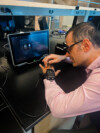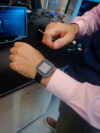The leading cause of death worldwide is cardiovascular diseases (CVDs): a broad range of conditions that affect the health of the heart. Although CVDs occur in a variety of ways, some can be attributed to behavioral and environmental risk factors: tobacco use, unhealthy diet, physical inactivity, harmful alcohol use, air pollution, etc. Proactive prevention efforts such as healthy eating, increasing physical activity, and stopping smoking can help disrupt the CVD epidemiological transition in low risk individuals and reduce prevalence, morbidity, and mortality.
One of the most informative vital signs to monitor overall cardiovascular health is blood pressure (BP). BP is the force of the blood pushing against the artery walls every heartbeat. Each time the heart beats, it pumps blood into the arteries. This results in the highest BP as the heart contracts; when the heart relaxes, the BP falls. High BP, also known as hypertension, directly increases the risk of heart attack, heart failure, and stroke. If the BP drops too low, known as hypotension, then body’s vital organs do not get enough oxygen and nutrients, which can lead to shock.
Today, healthy people or people at low risk of CVDs have their BP monitored during their routine health visits using a BP arm cuff. However, this single data point doesn’t account for any trend variations that may be happening when no data is being collected.
Dr. Benjamin Sanchez Terrones demonstrating a traditional BP monitoring device with a cuff.
Dr. Benjamin Sanchez Terrones demonstrates a cuffless electric blood pressure monitoring device.
For people with hypertension, anyone who may be at risk of developing it, and healthcare providers, the ability to conveniently monitor BP more often using a wearable device would be, in the words of Dr. Benjamin Sanchez Terrones, “a game-changer to address one of the largest worldwide epidemics.” Monitoring could be done in the clinic, at home, or anywhere.
Dr. Benjamin Sanchez Terrones is leading a $450,000 3-year grant from the National Science Foundation (NSF) to develop the science that will “enable the use of electricity to infer the blood pressure of a person without needing to use an inconvenient arm cuff.” This new technology will enable BP to be measured in the wrist with a smart watch or band for example, in a continuous, cuffless, and convenient way. This grant from the NSF will support Dr. Sanchez Terrones’ research and his colleagues Dr. Braxton Osting and Dr. Christel Hohenegger from the University of Utah Math Department.
More information about this and other exciting research happening at Dr. Sanchez Terrones lab can be found here.
Learn more about Electrical and Computer Engineering faculty research topics and discover ways to get involved in undergraduate research.
Written by Marlee Jeppsen.

